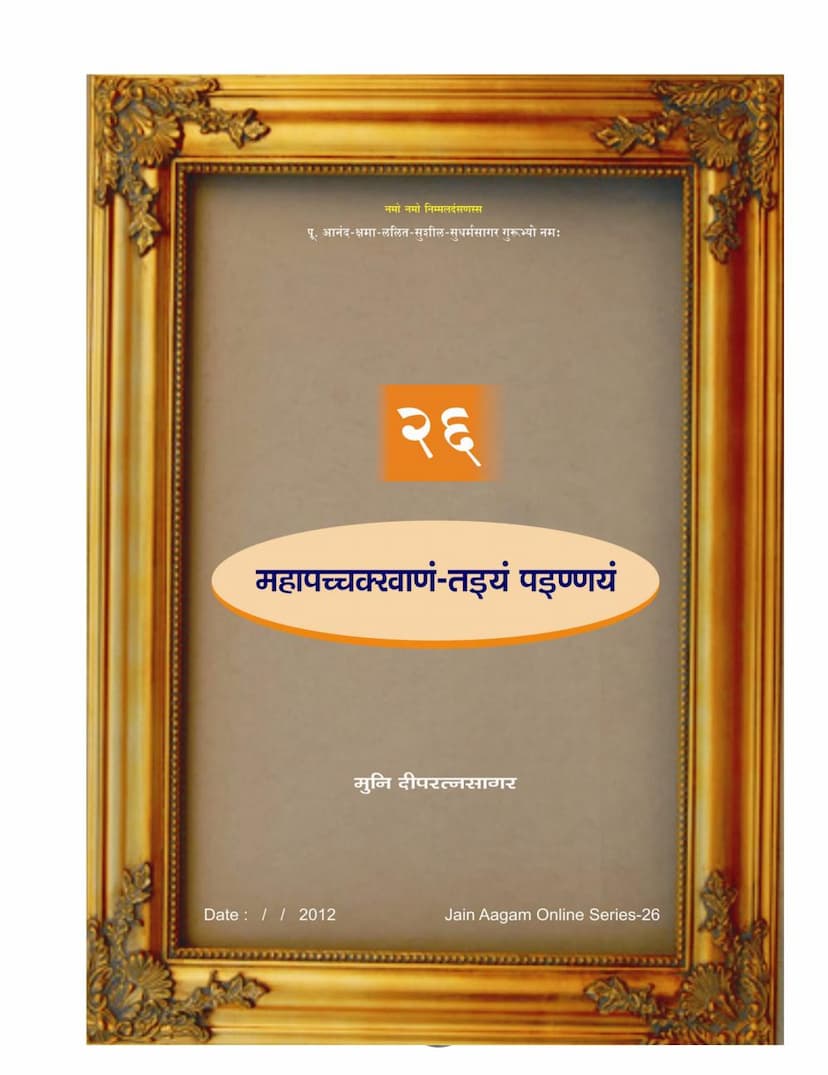Agam 26 Mahapacchakhanam Taiyam Painnayam Mulam PDF File
Added to library: September 1, 2025

Summary
This is a summary of the Jain text "Agam 26: Mahapacchakhanam Taiyam Painnayam Mulam," authored by Dipratnasagar and published by Deepratnasagar. The text, a collection of verses, focuses on the principles and practices of renunciation, repentance, and spiritual discipline within Jainism.
The summary provided, based on the page content, highlights the following key themes and sections:
I. Introduction and Structure (Pages 1-2):
- Salutations: The text begins with traditional Jain salutations, honoring the Tirthankaras (ford-makers), Siddhas (liberated souls), and the right vision (Nirmal Darshan). It also pays homage to the guru, Dipratnasagar.
- Title and Series: It identifies itself as "Jain Aagam Online Series-26" and specifically as "Mahapaccakkhāṇaṃ-taiyaṃ paiṇṇayaṃ" (Mahapachakhyana - the third Painnaya).
- Table of Contents (Ganthānukkamo): This section outlines the structure of the work, listing key topics:
- Mangalam (Auspiciousness): Invocation and initial verses.
- Vosarirṇa-khāmaṇā (Renunciation and Forgiveness): Verses 18-36.
- Nindā-garahā (Repentance and Self-Criticism): Verses 8-12.
- Bhāvanā (Meditations/Contemplations): Verses 13-17.
- Micchattvā-chāya, Āloyanā-pāyacchittādi (Abandonment of False Belief, Confession, Penance, etc.): Verses 18-36.
- Vividha-dharmopadesa-ādi (Various Teachings of Dharma, etc.): Verses 37-142.
II. Core Teachings and Practices (Pages 3-10):
The bulk of the text consists of verses (Gaha) that elaborate on various aspects of the Jain spiritual path. Key themes include:
-
Renunciation (Vosarirṇa/Chaya):
- Verses 4-7, 17, 33-34, 108-111: Emphasize the renunciation of external possessions (upadhi), internal attachments (rāga, dveṣa, harsa, dīnabhāva, etc.), bodily attachments, and worldly pleasures. This renunciation is to be performed through mind, speech, and body (tivihēṇa).
- Verses 109-110: Specifically mention renouncing thoughts, speech, and actions that are inappropriate or harmful.
-
Repentance and Confession (Nindā, Garahā, Āloyanā):
- Verses 8-10, 20-22, 65: Stress the importance of self-criticism, acknowledging wrongdoing, and confessing it to the Guru. This involves sincerely regretting past actions and vowing not to repeat them. The purity of confession is highlighted.
- Verses 24-26: Warn against not confessing even minor internal faults (bhāvasalla), emphasizing that true spiritual progress requires complete honesty.
- Verses 30-32: Describe the relief and lightness experienced after confessing sins to the Guru, similar to a load being lifted. Penance (prāyashchitta) prescribed by the Guru is essential.
-
Forgiveness (Khāmaṇā):
- Verses 7, 40, 140: Emphasize seeking forgiveness from all living beings and extending forgiveness to others. This is crucial for achieving equanimity (samādhi).
-
The Nature of the Self (Ātmā):
- Verses 13-16, 44, 49, 90: Differentiate the eternal, pure soul (ātman) from the transient external factors and bodily attachments. The soul is singular, experiences the consequences of its actions alone, and is inherently endowed with knowledge and perception.
-
The Cycle of Birth and Death (Saṃsāra) and Suffering:
- Verses 37-48, 50-64: Vividly describe the immense suffering and the endless cycle of births and deaths experienced due to ignorance, attachments, and desires. The verses recount the pain of innumerable lifetimes, various births, and worldly experiences, underscoring the impermanence of pleasure and the omnipresence of suffering.
- Verses 54-61: Use analogies like fire needing fuel to illustrate how desires are never truly satisfied. No amount of worldly pleasure can bring lasting contentment.
-
Noble Death (Pandiyamaraṇa):
- Verses 41-43, 45-49, 50, 85-93: A significant portion is dedicated to the concept of "Pandiyamaraṇa" – a wise and prepared death. This type of death is achieved through contemplation of past suffering, detachment from worldly relationships and possessions, and maintaining a state of equanimity. It is seen as the way to break the cycle of rebirth.
- Verses 91-92: Detail the means to achieve Pandiyamaraṇa: fasting (anaśana), meditation (dhyāna), and contemplation (bhāvanā).
-
Right Faith, Knowledge, and Conduct (Darśana-jnāna-chāritra):
- Verses 73, 75, 97, 99: Highlight the path of right faith, right knowledge, and right conduct as the means to spiritual liberation.
- Verses 67-72, 74, 76: Elaborate on the observance of the five Mahavratas (great vows) and the control of senses, mind, speech, and body. This includes avoiding anger, pride, deceit, greed, and controlling desires.
-
The Importance of the Guru and Scriptures:
- Verses 83, 94, 97, 114-119, 120: Underscore the indispensable role of the Guru and Jain scriptures (Agamas) in guiding the spiritual journey. The Guru's teachings are essential for understanding the path and overcoming obstacles.
- Verses 94-95: Emphasize that even those who have committed errors can achieve salvation if they confess their faults to the Guru and sincerely follow the path.
-
Overcoming Karma:
- Verses 99-101, 130: Describe how wisdom and diligent effort can burn away accumulated karma. A wise person can exhaust karma in a fraction of the time it takes an ignorant one.
-
Contemplation and Detachment (Saṃvega, Virāga):
- Verses 103-106: Stress the importance of cultivating detachment (virāga) and contemplation (saṃvega) by reflecting on the transient nature of the world and the suffering inherent in existence. This detachment leads to liberation.
-
The Path to Liberation (Nirvāṇa):
- Verses 23, 131, 138-139: Liberation is presented as the ultimate goal, achievable through diligent practice, proper conduct, and overcoming all impurities. The path can be accomplished in this life or over a few future lives depending on the intensity of practice.
III. Conclusion (Page 11):
- Final Exhortations: The text concludes with verses reinforcing the importance of constant vigilance, practicing detachment, and following the path of righteousness to achieve ultimate liberation. The emphasis is on living according to the teachings of the Tirthankaras.
In essence, "Agam 26: Mahapachakhyana" is a profound spiritual discourse that guides the aspirant towards self-realization through intense introspection, renunciation of worldly attachments, sincere repentance, acceptance of suffering as a part of the cycle, and unwavering devotion to the Jain path, all under the guidance of a spiritual preceptor.